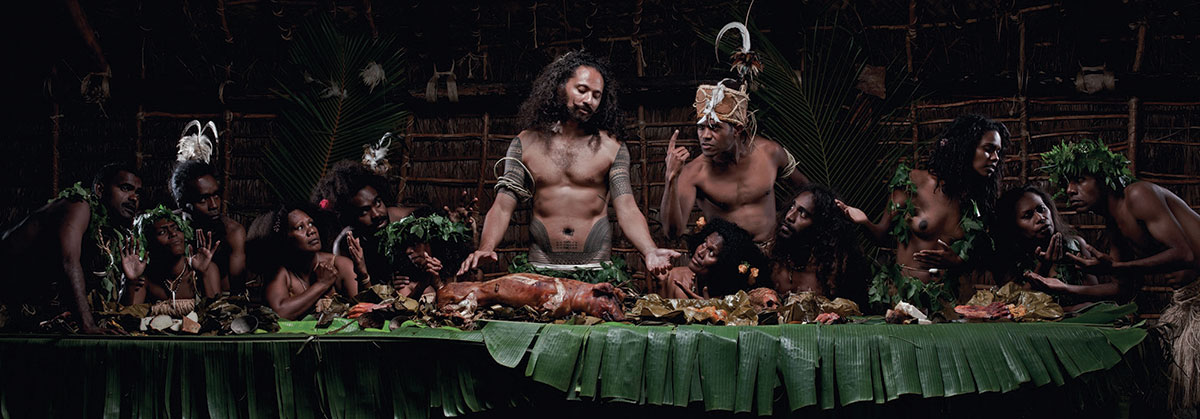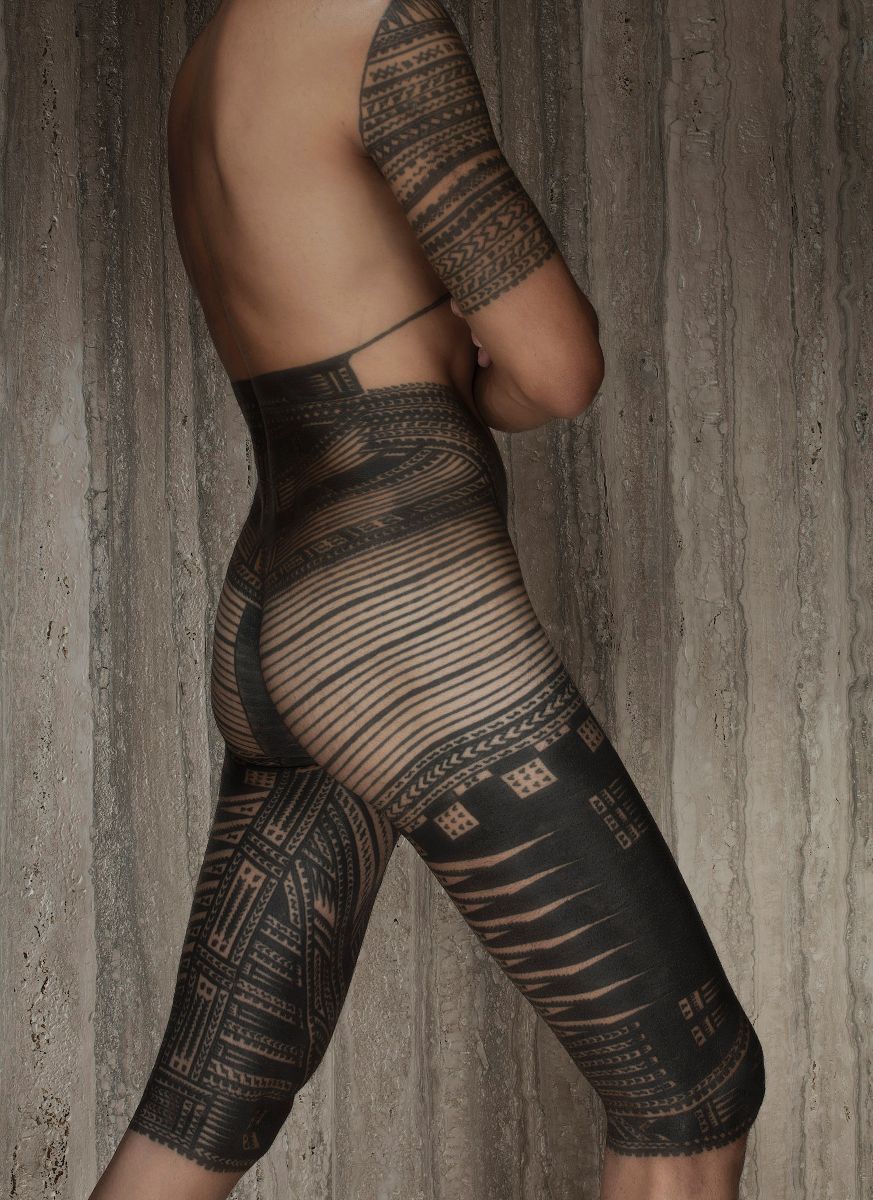
Two very different exhibitions are currently on view at the Cairns Regional Gallery. Greg Semu: “12” and James Morrison: Re-Imagining Papua New Guinea. While starkly distinct from each other, the broad undercurrents of history, identity, ambivalence and narration flow throughout the works.
Semu’s work is rich, lush and dramatic. His carefully staged photographs draw you in, requiring your full attention. Here we see the artist doing battle, in the face of extreme change: colonialism, neo-colonialism, post-colonialism. The essential questions posed are: are how to find oneself in the histories of the displaced peoples of the Pacific, and how to deal with the subsequent effects? How do people who have suffered the physical and psychic violence of colonialism, place themselves in the world, particularly without glorifying the warrior? His overtly masculine subjects are strong yet vulnerable. Through the sublime use of light, and careful staging of the photographs, Semu has produced aesthetically beautiful works in this overtly sensuous exhibition.
Maori, Kanak and Samoan bodies are placed in tableaux as the central figures. Culture, history and change are inscribed on these bodies, by tattoos, nudity, and clothing. The Samoan male tattoo, typified by Semu’s own body, forms a central organising principle and motif, appearing in several of the works to valorise the antiquity of Pacific peoples, especially in relation to colonial dispossession and the imposition of Christianity. His Battle of the Noble Savage works, commissioned by the Musée du Quai Branly, are a study in the tactics of British colonialism. By referencing the Napoleonic Wars, Semu opens up dialogue with the French about the New Zealand “Musket Wars” of the early 19th century, occurring at about the same time. This gives the French and others a factual reference point – focusing on the temporal and place-based – rather than a fantastic one.

Auto Portrait as La Pietà from The Last Cannibal Supper, a series of works that emerged from a residency in New Caledonia, re-presents the super-charged encounters with tradition, colonialism and Christianity. By reappropriating iconic paintings, notably about Christ, and Napoleon, Semu performs a “peaceful protest” against representations of Pacific Island peoples as peoples without histories, fashioned into certain types through European fantasies. Yet, Greg Semu’s works are also fantasies on historical events.
Like Semu’s photographs, James Morrison’s artworks are staged tableaux. In this imaginarium, the visual impact presents a combination of Henri Rousseau, zoological and botanical drawings, and sci-fi. The works are nostalgic and mythological, catapulting different times, places and people together in a phantasmorgoric dream. There is a riot of colour, a wild cacophony of imagery. Papua New Guinea is where Morrison spent his childhood and youth and through these works he re-visits, in his mind and heart, the place and the people – both real and fantastic. They reconcile his delightful experiences of growing up as a child and young man in Papua New Guinea, conscious of his Australian-ness.
The rhetorical appearance of the “Sepik” is a synecdoche for PNG as a whole, and for the fantastic, the fiction in his multiplex narratives. In a playful way, it belies the trick – that often the only connection between the work of art and PNG is the appearance of “Sepik” in its title. The Sepik for Morrison evokes a place that is the “heart of darkness”, a tourist mecca unlike the Eastern Highlands of his experience, nostalgia and imagination. He peoples his artworks with iconic representations of Papua New Guinean people from James Sinclair’s publication The Highlanders (e.g. Goodenough Bay, 1959; Building Goroka) and iconic Australians and Americans (e.g. Bungaree, Ray Bradbury and Patrick White at the Sepik River).
.jpg)
Morrison’s most recent works are Asaro and Goodenough Bay 1959. In Asaro James appears as a child alongside his father. This pencil drawing is noticeably less crowded, and his most playful work in the exhibition. There is a lot of blank space allowing “more fresh air”[1]. to come through. In stark contrast, the only colour among the variations of grey and black is the yellow of the cat’s eyes. Goodenough Bay is a “War of the Worlds” and ‘Paradise Lost’. 1959 (Morrison’s birth year) saw a spate of UFO sightings in PNG. Maria, the robot (from Lang’s “Metropolis”), appears beside a Highland woman. Plants, birds, and snakes are arranged in a tableau of feasting opulence – the seduction of meringue, strawberry, ice cream, and tropical fruits. A white hand offers a strawberry to the woman (out of place in coastal Goodenough), while artefacts stand sentinel to the unfolding drama.
Mediation and ambivalence peek through at every turn. In his Australian–Sepik paintings, we see Albert Namatjira and Bungaree mediating Aboriginal and European worlds through painting and through exploration with Matthew Flinders and Phillip Parker King. The meaning is open-ended, both for Morrison and the viewer. These paintings and drawings that so deliberately lack coherence, as musings on the world, have taken on a life of their own. They seamlessly slip between the magical and the real.
Morrison describes his childhood as peopled with powerful and magical forces, including Grimm’s fairy tales. “Lying on your back … drifting up through the atmosphere and into space, you see all the infinite possibilities, like a child dreaming of foreign places at the edge of consciousness.” And it is indeed to these places that Morrison transports us. These expressions, wrought in precise, fine detail and thrown together with lurid flourish are the painterly equivalent of the brilliant magical realism of South American writers such as Garcia Marquez, Allende and Armado.
.jpg)
Footnotes
- ^ This and subsequent quotations are from an artist talk at the Cairns Regional Gallery on 20 April 2016.

